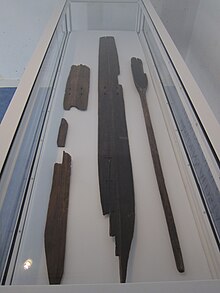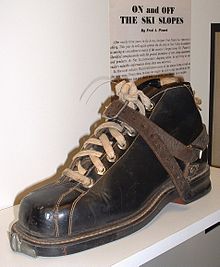History of skiing
The earliest archaeological examples of skis were found in Karelia (a region in western Russia on the border with Finland) and date to 6000 BCE.In the 20th century it was practiced in snow-covered regions worldwide, providing a market for the development of ski resorts and their related communities.A rock carving at Norway, from about 1000 or 500 BCE depicts a skier seemingly about to shoot with bow and arrow, with skis positioned in an angle (rather than parallel) to offer good support.[10] 5000-year-old wall paintings suggest skiing had also evolved separately in the Xinjiang region by the Tuvan people; however, this continues to be debated.[9][12][13] The first primitive Scandinavian ski was found in a peat bog in Hoting in Jämtland County in Sweden; it dates back to 4500 or 2500 BCE.The central Nordic type also had one short with fur (the andor) and one long, and was used in large parts of Norway, Sweden and Finland.[22] Paulus Diaconus mentioned what may have been Sami and described how they chased animals by a twisted piece of wood that they painstakingly shaped to resemble a bow.[15] Egil Skallagrimsson's 950 CE saga describes King Haakon the Good's practice of sending his tax collectors out on skis.Swedish writer Olaus Magnus's 1555 A Description of the Northern Peoples describes skiers and their climbing skins in Scricfinnia in what is now Norway.A 1593 inventory of the "choicest rarities" on display at the Leiden University included:[27] A Pair of Stilts or Skates, with which the Norwegians, Laplanders, and Finlanders run down high snawy mountaines with almost an incaepible swift pace.The day will surely come when even those of other European nations are learning to take advantage of this convenient and cheap mode of transport.Norwegian immigrants used skis ("Norwegian snowshoes") in the US Midwest from around 1836.[21] In the First World War, Austro-Hungarian troops on the Italian front used skis and wore snow camouflage smocks and overtrousers over their uniforms.The design included steel edges (invented in 1928 in Austria,[66]) and the exterior surfaces were made of phenol formaldehyde resin which could hold wax.[70] In the early days of skiing the binding was also similar to those of a contemporary snowshoe, generally consisting of a leather strap fastened over the toe of the boot.[71] The cable binding remained in use, and even increased in popularity, throughout this period as cross-country skiing developed into a major sport of its own.[75] Boots with the sole extended rearward to produce a flange for the cable to firmly latch became common, as did designs with semi-circular indentations on the heel for the same purpose.Johannes Scheffer in Argentoratensis Lapponiæ ("History of Lapland") in 1673 probably gave the first recorded instruction for ski wax application[76] He advised skiers to use pine tar pitch and rosin.Wax does not stick to aluminum, so the base under the foot included grips to prevent backsliding, a precursor of modern fish scale waxless skis.[67] Klister, a sticky material, which provides grip on snow of all temperatures that has become coarse-grained as a result of multiple freeze-thaw cycles or wind packing, was invented and patented in 1913 by Peter Østbye.These designs were deemed too heavy, and following the conclusion of World War II, it became much more common to make the baskets out of some plastic material, a practice which has continued until today.Cross country and freestyle skiing utilize much longer, straight poles, so as to make it easier for the skier to reach the ground while traversing the mountain.Created by Bob Smith, an orthodontist from Sun Valley, Utah, these goggles allowed for air flow behind the lens in order to limit fogging and improve the skier's vision.Despite these findings and analysis, in 1984, shortly after the passing of these regulations, it was found that "the mix of lens materials was approximately 78% glass, 11% plastic, and 11% polycarbonate.










SkiingKareliaScandinaviaski resortsOld NorseNorwegianSwedishEnglishFrenchSpanishPortugueseItalianGermanFinnishEstonianLule SamiKalvträskskidanMoscowRock carvings at AltaOnega petroglyphsWhite Sea rock carvingsNorwayRock drawingsWhite SeaRussiaWhite Sea carvingsXinjiangTuvan peopleJämtland CountySwedenNordlandglacierReinheimenOpplandGreenlandOb riverLesjaskogsvatnetSkjåkWestern Han DynastyAltai MountainsProcopiusNorse mythologySkaðiSami peoplePaulus DiaconusEgil SkallagrimssonHaakon the GoodGulating lawFridtjof NansenSverdrupKristiansenSverre of NorwayTønsberg FortressHaakon IV of NorwayGudbrandsdalenØsterdalenBirkebeinerrennetSki warfareDanishSaxo GrammaticuscavalryOlaus MagnusA Description of the Northern PeoplesScricfinniaTrondheimLeiden UniversityFilefjellSnowshoe ThompsonBuenos Aires - Valparaiso railway lineRoald AmundsenSouth Pole ExpeditionconsulFirst World WarAustro-Hungarian troopssnow camouflageuniformsSecond World WarMoscow Strikes BackWinter Warsnowshoescable bindingsski polesFridtjov NansenItalian PiedmontVal PelliceAdolfo KindTelemarkOlaf Ryeski jumperTromsøTrøndelagTrysilOnion ValleyCaliforniaSkiing established in AustraliaKiandraKiandra Snow Shoe Clubski jumpingNorth AmericaNansen Ski ClubBerlin, New HampshireExposition UniverselleHenry DuhamelChamrousseslalomKitzbühelWilliam Adolf Baillie GrohmanHenrik AngellGrenobleStarkad Ski ClubOlaus JeldnessBardonecchiaU.S. national ski associationAlpine Ski ClubVasaloppetArnold LunnVarsity TripInternational Ski FederationWinter OlympicsKandahar Ski ClubMürrenSwitzerlandGiant Slalom1952 Winter Olympicsfreestyle skiinginstant-replay